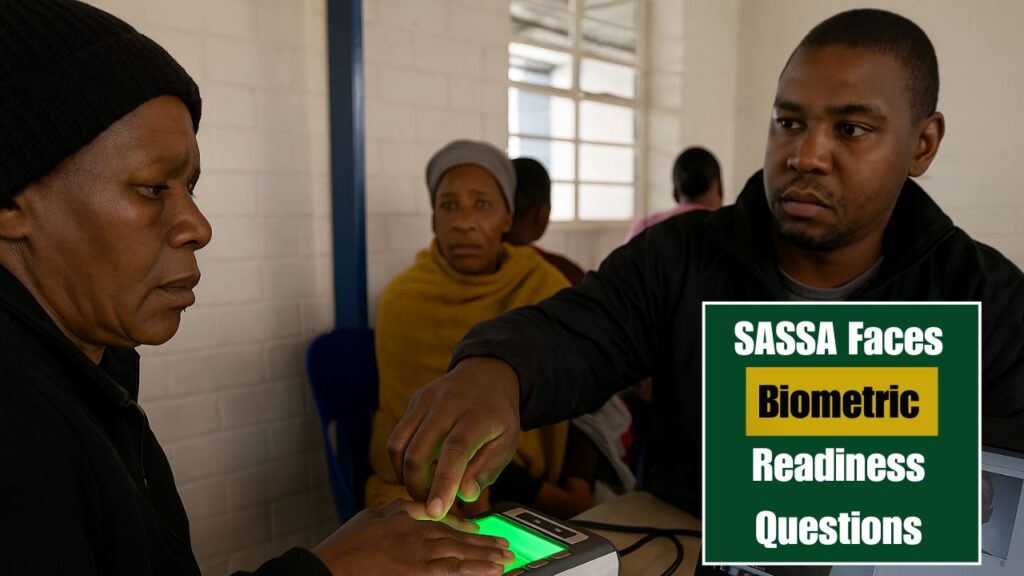The South African Social Security Agency (SASSA) has initiated a nationwide biometric enrolment program to improve the security and efficiency of social grant payments. However, the human rights organization Black Sash has expressed serious concerns about the readiness of the system and its potential impact on vulnerable beneficiaries. The group warns that without proper planning and community education, many grant recipients—especially the elderly and those in rural areas—might face disruptions in accessing their payments. These concerns come as SASSA aims to modernize its verification process amid growing cases of fraud.

SASSA Biometric Enrolment and Beneficiary Challenges in South Africa
SASSA’s new biometric enrolment system aims to verify the identity of over 28 million beneficiaries through fingerprints, facial recognition, and other digital means. The initiative is designed to reduce fraud, streamline payment processing, and ensure that grants reach the right individuals. However, the rollout has raised logistical challenges, including limited access to technology in rural communities, insufficient training for SASSA field staff, and concerns over data privacy. Civil society groups urge the government to prioritize accessibility and provide support to elderly and disabled grant recipients during the transition.
Black Sash’s Concerns Over Readiness and Impact on Grant Payments
The advocacy group Black Sash has voiced strong concerns that the biometric enrolment system might not be fully ready for implementation. They warn that system failures or delays could interrupt payments for millions of South Africans who rely on grants for daily survival. The organization calls for transparency from SASSA and Postbank regarding system testing, contingency measures, and data protection policies. Black Sash also recommends extending public awareness campaigns and providing manual alternatives until the new system proves stable and accessible to all beneficiaries.
Also Read : SA Update: R2,190 Care Grant Goes Live This October – Who Qualifies and When You’ll Be Paid
Government Response and Assurance for South African Grant Beneficiaries
The South African government has assured citizens that the biometric enrolment process will be gradual and that no eligible beneficiary will lose access to their social grants during the transition. Officials from the Department of Social Development have stated that extra staff will be deployed in rural areas to assist those unable to travel to enrolment centers. Mobile units and community partnerships will help ensure inclusivity. Despite these assurances, NGOs remain cautious, urging continuous monitoring to prevent exclusion and technical errors from disrupting vital income support.
Key Details About SASSA’s Biometric Enrolment Implementation
SASSA’s biometric system is part of its broader digital transformation strategy for 2025, intended to enhance the security of public welfare services. The system integrates with Postbank databases to ensure that grant payments go directly to verified beneficiaries. Pilot tests have been completed in select provinces, with national rollout expected to follow in phases. Beneficiaries are encouraged to update their personal information and report any issues during the enrolment period. While the technology promises efficiency, the success of this initiative depends on clear communication and adequate support at the grassroots level.
| Aspect | Details |
|---|---|
| Program Name | SASSA Biometric Enrolment System |
| Implementing Authority | South African Social Security Agency (SASSA) |
| Primary Objective | Prevent fraud and ensure accurate beneficiary verification |
| Concern Raised By | Black Sash Human Rights Organization |
| Rollout Phase | Gradual national implementation in 2025 |
| Beneficiaries Affected | Over 28 million South Africans |
Also Read : South Africa Govt Employees Rejoice! 22% Allowance Hike + Bonus – Check Your Benefits Now!
FAQs on SASSA’s Biometric Enrolment and Black Sash Concerns
Q1: What is SASSA’s biometric enrolment program?
A1: It’s a system to verify beneficiaries using digital fingerprints and facial recognition to prevent fraud.
Q2: Why is Black Sash concerned about this rollout?
A2: They fear system readiness issues could disrupt grant payments for vulnerable recipients.
Q3: How will rural beneficiaries complete biometric enrolment?
A3: Mobile enrolment units and community outreach programs will assist them locally.
Q4: Will any beneficiaries lose their grants during the transition?
A4: The government has assured that no eligible person will lose access to payments during implementation.




